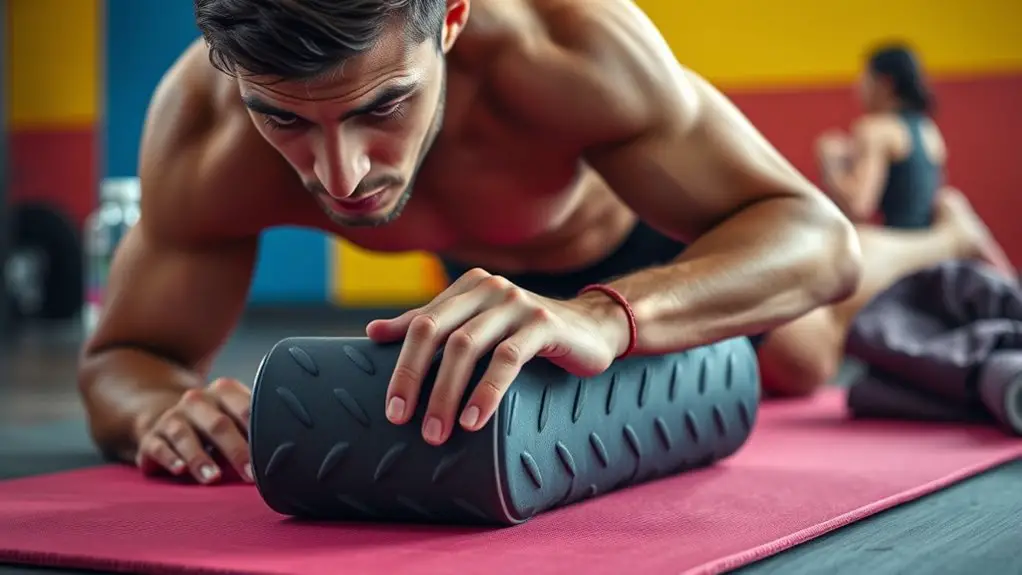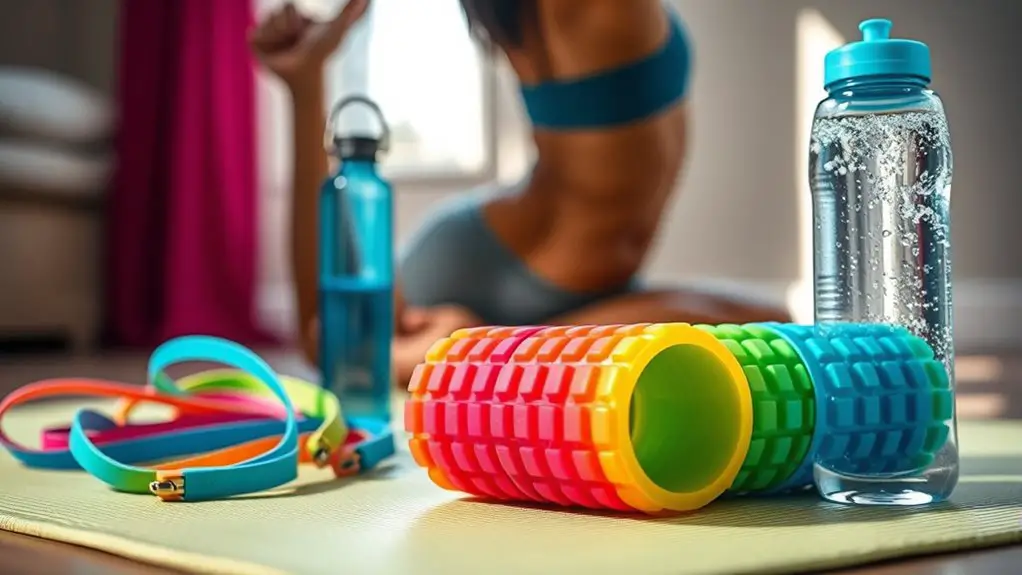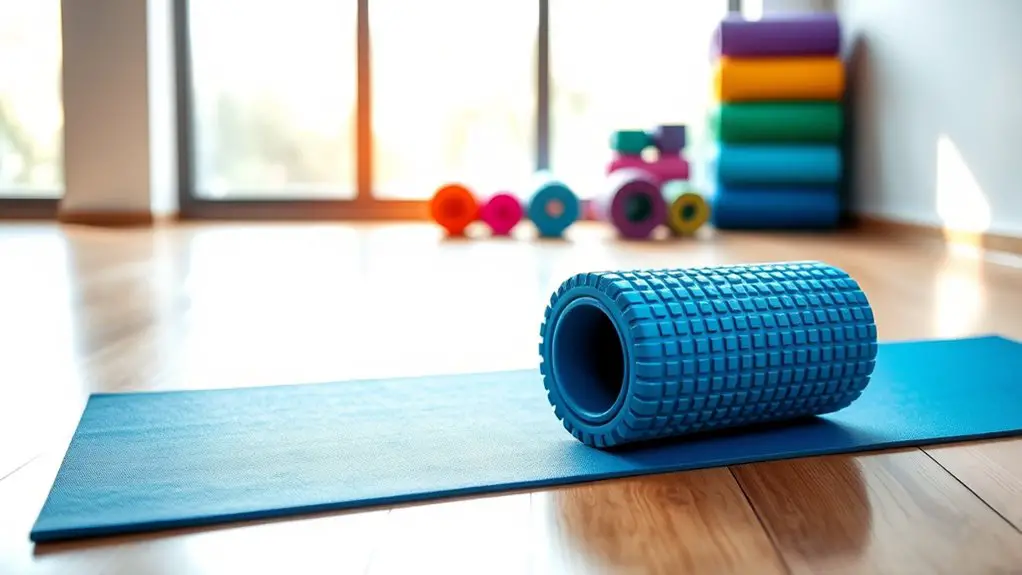How to Use Foam Rolling for Muscle Recovery After Gym Workouts

To use foam rolling for muscle recovery after gym workouts, spend 10-15 minutes targeting tight areas. Start with slow rolling over muscle fibers, focusing on painful spots for about 30 seconds each. Remember to breathe deeply to aid relaxation. Incorporate foam rolling post-workout to alleviate soreness and enhance flexibility. Aim for 3-5 sessions a week to maximize benefits. Combine this technique with stretching and hydration for ideal recovery. There’s more to explore on effective foam rolling techniques and tips!
Understanding Foam Rolling: What It Is and How It Works

When you’re looking to enhance your muscle recovery, understanding foam rolling can be a game changer. Foam rolling is a self-myofascial release technique that helps alleviate muscle tightness and improve flexibility. By applying pressure to specific muscle groups, you’re effectively breaking down knots and increasing blood flow, which is essential for recovery.
The muscle recovery science behind foam rolling is rooted in its ability to stimulate the fascia, the connective tissue surrounding muscles. This stimulation can lead to reduced soreness and quicker recovery times. To implement foam rolling techniques effectively, focus on areas that feel particularly tight, rolling slowly and pausing on tender spots for several seconds.
Incorporating foam rolling into your routine can drastically enhance your recovery process, allowing you to get back to your workouts feeling refreshed and ready. Remember, consistency is key to reaping the benefits of this powerful technique.
The Benefits of Foam Rolling for Muscle Recovery
Foam rolling offers significant benefits for muscle recovery that you won’t want to overlook. It can improve blood circulation, helping to deliver essential nutrients to your muscles, while also reducing soreness after intense workouts. Additionally, regular foam rolling enhances your flexibility and mobility, making it an essential tool in your recovery routine.
Improved Blood Circulation
Although many overlook the role of blood circulation in muscle recovery, incorporating foam rolling into your routine can greatly enhance this essential process. Improved circulation benefits muscle oxygenation by delivering more nutrients and removing waste products, which accelerates recovery. As you roll, you’re effectively stimulating blood flow, promoting tissue repair, and reducing muscle fatigue.
| Benefit | How Foam Rolling Helps | Result |
|---|---|---|
| Muscle Oxygenation | Increases blood flow to muscles | Enhanced performance |
| Nutrient Delivery | Eases tension in tight muscles | Faster recovery |
| Waste Removal | Breaks up adhesions in muscle tissue | Reduced fatigue |
Reduced Muscle Soreness
Enhanced blood circulation not only boosts muscle oxygenation but also plays a key role in reducing muscle soreness. When you use a foam roller, you’re fundamentally giving your muscles a massage that encourages the removal of metabolic waste, aiding in muscle recovery. This process can considerably decrease pain and discomfort after intense workouts, allowing you to bounce back faster. Foam rolling helps release tight knots and tension in your muscles, which contributes to overall pain reduction. The targeted pressure increases blood flow, facilitating nutrient delivery to the affected areas. Incorporating foam rolling into your post-workout routine can transform your recovery process, making it easier for you to stay consistent and achieve your fitness goals without the burden of prolonged soreness.
Enhanced Flexibility and Mobility
Incorporating foam rolling into your routine can considerably boost your flexibility and mobility. By releasing tight muscles and fascia, foam rolling prepares your body for dynamic stretches and mobility drills. This practice increases blood flow, allowing your muscles to respond better to movement, which is essential for enhancing range of motion.
When you combine foam rolling with your dynamic stretches, you’ll notice improved performance and reduced risk of injury. It helps to loosen up the connective tissues, making it easier to execute those challenging mobility drills. Consistency is key; using a foam roller regularly can lead to significant gains in flexibility over time. So, grab your foam roller and start rolling your way to better mobility today!
When to Incorporate Foam Rolling Into Your Routine
When should you consider adding foam rolling to your routine? Integrating foam rolling into both your pre workout routine and post workout recovery can notably enhance your performance and overall muscle health. Before you hit the gym, spend a few minutes foam rolling to activate your muscles and increase blood flow. This can help reduce the risk of injury and improve your range of motion, setting you up for a more effective workout.
After your session, foam rolling plays an essential role in post workout recovery. It helps alleviate muscle tightness, speeds up recovery by promoting circulation, and can even decrease soreness. Aim to foam roll for 10-15 minutes, focusing on areas that feel particularly tense. By strategically incorporating foam rolling into both phases of your workout regimen, you’re not just enhancing your performance; you’re also investing in your long-term muscle health.
Essential Techniques for Effective Foam Rolling

Mastering a few essential techniques can greatly improve your foam rolling experience and maximize its benefits for muscle recovery. Start by choosing the right foam roller types for your needs—whether it’s a basic firm roller or one with ridges for deep tissue work.
Here are a few techniques to enhance your sessions:
| Technique | Description | Tips |
|---|---|---|
| Slow Rolling | Move slowly over tight spots | Spend 30 seconds on each area |
| Cross-Friction | Roll perpendicular to muscle fibers | Focus on painful areas |
| Breathing | Inhale deeply while rolling | Helps with relaxation |
Incorporating advanced techniques, like using a vibrating foam roller, can further enhance recovery. Remember, consistency is key, so make foam rolling a regular part of your post-workout routine!
Targeting Major Muscle Groups for Optimal Recovery
After honing your foam rolling techniques, it’s important to focus on the major muscle groups that can benefit the most from this practice. By utilizing targeted foam rolling, you can enhance your recovery and reduce soreness effectively. Start with your quads, as they often bear the brunt of leg workouts. Roll slowly along the muscle, pausing on any tight spots. Next, shift to your hamstrings, ensuring you maintain proper form to avoid injury. Don’t forget your back; a few minutes on your thoracic region can alleviate tension and improve posture. Finally, give attention to your calves and glutes, as these areas play a significant role in overall mobility. By concentrating your efforts on these key muscle groups, you’re setting yourself up for ideal recovery, allowing you to bounce back stronger for your next workout. Remember, consistency in your muscle group focus will yield the best results!
Common Mistakes to Avoid While Foam Rolling

While foam rolling can be an effective tool for muscle recovery, it’s easy to make mistakes that can hinder your progress. One common issue is improper technique. Rolling too quickly can prevent your muscles from fully responding to the pressure, reducing the effectiveness of the release. Instead, take your time and focus on the targeted areas.
Another mistake involves pressure. Many people apply too much weight too soon, leading to unnecessary pain or injury. Start with moderate pressure, and gradually increase it as your muscles adapt. Remember, foam rolling should feel uncomfortable but not excruciating.
Additionally, don’t neglect your breathing; holding your breath can increase tension in your muscles. Finally, avoid rolling over bony areas or joints, as this can cause more harm than good. By being mindful of these technique errors and pressure mistakes, you’ll maximize the benefits of foam rolling and support your recovery effectively.
How Long and How Often to Foam Roll
To maximize your muscle recovery with foam rolling, it’s important to understand how often and how long to roll. Aim for at least two to three sessions per week, dedicating around 10 to 15 minutes to each session for best results. By committing to this routine, you’ll enhance your flexibility and reduce muscle soreness effectively.
Frequency of Foam Rolling
Regularly incorporating foam rolling into your routine can greatly enhance muscle recovery and flexibility. To maximize benefits, follow frequency guidelines that recommend foam rolling 3 to 5 times a week, especially on days you work out. This helps alleviate soreness and improve tissue elasticity. Depending on your needs, consider different foam roller types; a firmer roller can target deeper muscle layers, while a softer one is ideal for sensitive areas. Listen to your body—if you feel particularly tight or sore, increase your frequency, but avoid overdoing it. Consistency is key to seeing results, so make foam rolling a non-negotiable part of your post-workout regimen. You’ll be amazed at how it contributes to your overall performance and recovery.
Duration of Each Session
Incorporating foam rolling into your routine involves not just frequency but also the duration of each session. Ideally, aim for a session duration of 10 to 15 minutes, focusing on key muscle groups that need attention. This timeframe allows you to effectively release tension while avoiding overstimulation. For ideal timing, consider rolling immediately after your workout or as part of your recovery routine on rest days. Consistency is key; try to foam roll at least three to four times a week for the best results. Remember to listen to your body—if a specific area feels particularly tight, don’t hesitate to spend a bit more time there. Happy rolling!
Combining Foam Rolling With Other Recovery Methods

While foam rolling is an effective standalone method for muscle recovery, combining it with other recovery techniques can enhance your overall results. Incorporating practices like dynamic stretching, hydration, and proper nutrition can greatly improve your recovery process. After foam rolling, consider a few minutes of gentle stretching to further enhance muscle flexibility. This combination helps to reduce soreness and improves your range of motion.
Additionally, staying hydrated is vital; water helps flush out toxins released during foam rolling. Pairing foam rolling with a balanced post-workout meal rich in protein and carbohydrates can also accelerate muscle repair.
Lastly, don’t underestimate the power of rest. Allowing your muscles adequate recovery time is essential for best performance. By integrating these recovery techniques with foam rolling, you’ll not only feel better but also enhance your workout performance, ensuring you’re ready for your next gym session.
Foam Rolling for Specific Fitness Goals
When you’re aiming for specific fitness goals, foam rolling can be a game changer for your muscle recovery and performance. By targeting specific muscle groups, you can enhance flexibility and mobility, allowing you to push your limits effectively. Incorporating these techniques into your routine will not only speed up recovery but also help you achieve your desired results faster.
Targeted Muscle Recovery Techniques
Foam rolling can be a game-changer for your muscle recovery, especially when you target specific areas based on your fitness goals. Using targeted techniques can help alleviate soreness in particular muscle groups, enhancing your overall performance.
| Fitness Goal | Targeted Muscle Groups |
|---|---|
| Post-Workout Recovery | Hamstrings, Quads |
| Improved Endurance | Calves, Hip Flexors |
| Enhanced Strength | Back, Chest |
| Injury Prevention | Shoulders, Glutes |
Incorporating foam rolling into your routine can improve blood flow and reduce tension in these areas. By focusing on these targeted techniques, you’ll not only boost recovery but also enhance your workout efficiency. Remember, consistency is key to maximizing benefits!
Enhancing Flexibility and Mobility
To enhance flexibility and mobility, incorporating foam rolling into your routine can yield impressive results, especially when you focus on areas that often restrict movement. Combining foam rolling with dynamic stretching creates a powerful approach to myofascial release, allowing your muscles to perform better.
Consider targeting these key areas:
- Hip flexors for improved leg movement
- Quadriceps to enhance knee flexibility
- Shoulders to increase upper body range
- Back for overall spinal mobility
Tips for Choosing the Right Foam Roller

Choosing the right foam roller can greatly enhance your muscle recovery experience, and with so many options available, it’s important to know what to look for. Start by pondering the different roller types: standard, trigger point, or vibrating rollers. Each serves a unique purpose based on your needs. For instance, a standard roller is great for general use, while a trigger point roller targets specific muscle knots.
Next, think about foam density. Softer rollers are perfect for beginners or sensitive muscles, while firmer options provide deeper tissue massage for experienced users. This choice can greatly influence your comfort and effectiveness during recovery sessions.
Finally, don’t forget to reflect on size—longer rollers are excellent for larger muscle groups, while shorter ones are great for portability. By understanding these factors, you’ll find the perfect foam roller to optimize your recovery journey.
Frequently Asked Questions
Can Foam Rolling Help Prevent Injuries During Workouts?
Yes, foam rolling can indeed help with injury prevention during workouts. By enhancing muscle flexibility, you’re allowing your body to move more freely, reducing the risk of strains or tears. When you roll out your muscles, you increase blood flow and break down adhesions, which can contribute to injuries. Incorporating foam rolling into your routine not only prepares your muscles for activity but also aids in recovery, keeping you strong and injury-free.
Is Foam Rolling Safe for Beginners?
Diving into foam rolling is like stepping onto a path of self-improvement. Yes, foam rolling is safe for beginners when you use proper techniques. Start slow, focusing on areas that feel tight, and listen to your body. Don’t press too hard; it’s about easing tension, not creating pain. As you gain comfort and control, you’ll discover how beneficial it can be for your muscles and overall recovery. Embrace the journey!
How Does Foam Rolling Compare to Massage Therapy?
When you compare foam rolling to massage therapy, you’ll notice distinct foam benefits. Foam rolling uses self-myofascial release techniques that target muscle tightness and improve flexibility. On the other hand, massage therapy employs various massage techniques to enhance circulation and relieve stress. While both can aid recovery, foam rolling is a more accessible option for consistent use at home. Incorporating both methods can maximize your recovery and overall performance.
Can Foam Rolling Be Beneficial for Older Adults?
Absolutely, foam rolling can be beneficial for older adults! It helps improve flexibility, reduces muscle soreness, and enhances blood circulation. Incorporating foam rolling into your routine can promote better mobility and make daily activities easier. You’ll find that regular use can alleviate tension and stiffness, making movements feel more comfortable. So, if you’re looking to boost your well-being, consider adding foam rolling to your regimen—it’s a simple yet effective way to support your body!
Are There Any Contraindications for Using Foam Rollers?
You’d think foam rollers are harmless, right? Well, not quite! If you’ve got certain medical conditions, like osteoporosis or recent surgeries, using a foam roller might not be the safest choice for you. Always prioritize foam roller safety—consult with your healthcare provider before diving in. Remember, while foam rolling can be beneficial, it’s essential to recognize when it’s better to skip it to avoid injury and guarantee your recovery stays on track.





